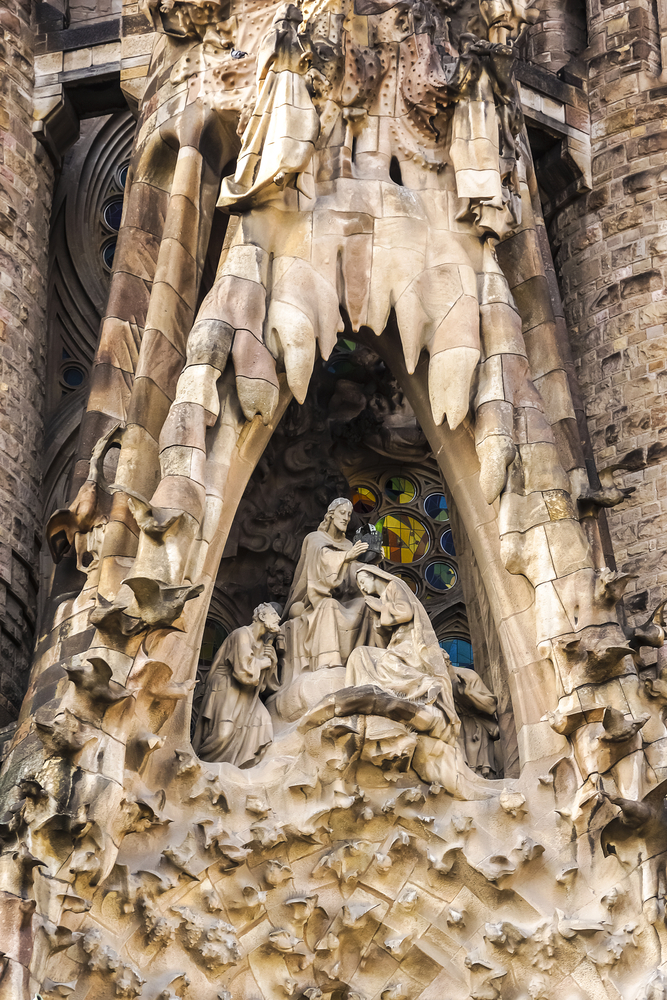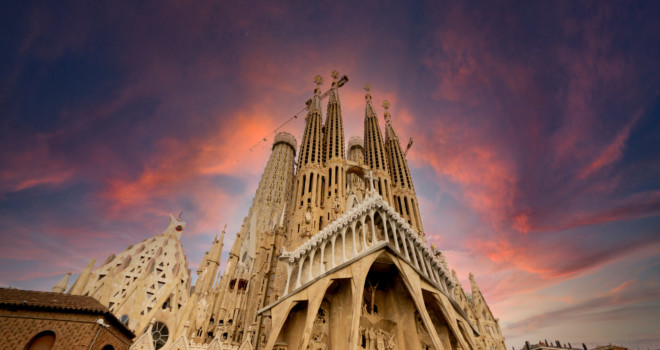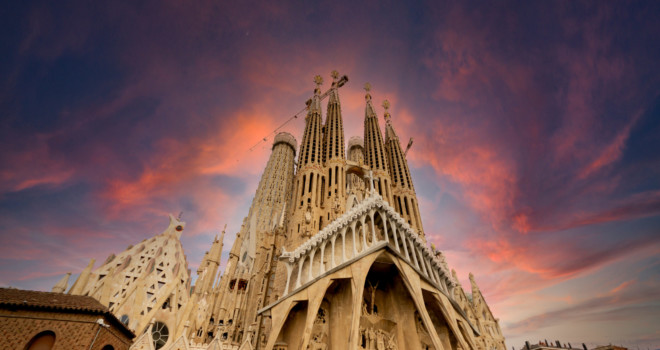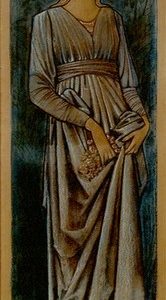Among the precious treasures of the Church that bring about the salvation of souls, which we must recover to save our families and rebuild a Christian society, is the Sacrament of Matrimony. Is it not darkened today above all because we rarely proclaim this forgotten gem among the seven sacraments, no longer let it shine in our lives? Hope rises by what is probably the most improbable phenomenon of our time, the construction of the Sagrada Família, the Expiatory Church of the Holy Family, right in the middle of the modern metropolis of Barcelona.
From the Passion to the Incarnation
If the Passion facade is the overcoming of modernity in its austere seriousness, the path around the almost completely finished choir shows a Gothic style growing from slender trunks, blossoming serenely, entwining, sprouting its leaves. It feels quite Cistercian in its playful basic shapes. It is an overcoming of modernity in the clear-sounding, cheerful smile of the angels, in a serenity like the faces of angels playing music on van Eyck’s Ghent altar. This Gothic artist was in Spain, too, after all – Isabella of Castile (1451-1504), invited this Catholic artist and loved his art and that of all the other great Flemish painters she collected. But isn’t something missing? Where are the flying buttresses? Without them, the “diaphanous” Gothic walls, without masonry dissolving into translucent light, without a Gothic choir, seems unthinkable.
“Gaudí held that Gothic, though wonderful, was basically a crippled style,” replies art historian Gijs van Hensbergen. “The buttresses were to him like an invalid’s crutches, beautiful but unsuccessful attempts to conceal the building’s inability to rise skyward without outside help. The spectacular upward sweep of earthbound stone was an illusion Gaudí laboriously tried to show and then gracefully conceal.” Clearly, Gaudí was not creating a neo-Gothic style, but a new Gothic that continued and perfected the Gothic architectural idea. Gaudí’s Gothic does not need buttress arches like the choir of Cologne Cathedral to accommodate lateral thrusts. Yet everything remains slender and soaring. Another architectural idea of Gaudí is immediately apparent: The plant-like nature of the choir is not ornamentally conceived. Gaudí’s beauty follows from the truth of statics, from authentically felt and mathematically thought-out nature. It is Gaudí’s own version of the principle pulchritudo splendor veritatis—beauty being the splendor of truth.

Gaudí’s Mystery of Incarnation
Finally, the Christmas facade, the mystery of the Incarnation—begun by Gaudí himself, which he imagines in grotto-cave forms—reveals itself. In the evening shadows, they remind our visitors of the stalactite ceilings of the fairy-tale oriental rooms of the Alhambra in Granada or the stalactite halls deep in the mountains of the Sierra Nevada. The Nativity in the Grotto of Bethlehem was also Oriental. Again, our couple was touched to their innermost hearts, so intimate, tender, touching was the scene; they were inclined to kneel in adoration, together with the shepherds and the wise kings at the facade. The green tree of life, a fir tree crowning the facade with white birds of paradise, awakens the Christmas longing for paradise on a Catalan summer evening. All the familiar details are brought to mind and heart by this facade, the tranquility on the flight to Egypt, the slaughter of the Innocents, Jesus at work with Joseph, the carpenter, his teaching in the temple, and all the other episodes, and above all the coronation of Mary.
The architectural idea of the Christmas facade is simple – three decorated arches represent hope, love and faith. From left to right, the Mystery of the Incarnation unfolds with supreme realism and effervescent narrative joy. A dense array of diverse images and details that entice the eye crowd the stone like barnacles on the sea cliffs. Only at first glance is Gaudí’s almost baroque extravagance and his gothically felt horror vacui confusing. But once the eye is focused, it beholds Gaudí’s love of truthfulness. Legibility is a central principle of his concept; for he wanted to create a Bible in stone. His insistence on realism wants to be literal on some level, leaving little to the imagination. Gaudí insisted on the primacy of divine creation through faithful imitatio Dei of divine craft, insisting on perfect mimesis whenever possible. In 1930, Gaudí’s student Domènec Sugrañes (1878-1938) completed the Christmas facade except for the choir of 15 angels playing music.
Our visitors have come to contemplate the facades of the Sagrada Família in a different order, and perhaps more appropriately for their own time, than Gaudí would have imagined. “If, instead of building this ornate, indeed over-richly decorated facade, we had begun with the hard, bare and skeletal Passion facade, it would have met with the rejection of the people,” Gaudí notes. Josep Maria Subirachs i Sitjar (1927-2014), the artist of the Passion facade who dedicated the last two decades of his work to it, thus meets Gaudí’s building ideas. This is all the more astonishing, because this secular artist, who called himself an agnostic with a culturally conditioned attachment to Catholicism, had accepted the commission only on condition that he not try to imitate Gaudí. Where Gaudí, appropriately for Christmas, uses organic forms and the curves of grace he associates with God, Subirachs is hard, cold, angular, and uncomfortable. But still, as a rugged, forbidding, even sinister structure, the Passion facade had been thought out by Gaudí who sketched it down to the last detail.
Entering a Sacred Cathedral Forest
In December 2015, after many years of work, the last of the four gates made of bronze, glass and other materials was installed, 7×3 meters in size, leading from the Christmas facade into the Sagrada Família. Their Japanese creator Etsuro Sotoo (b.1953), who became Catholic through his study of Gaudí, depicts on them, full of symbolism, ivy, flower petals, gourds and lilies, cockchafers, wasps, flies, grasshoppers, butterflies, centipedes, crickets, ladybugs, caterpillars and ants.
In 1991, Sooto was baptized in the crypt of the Sagrada Família and took the Christian name Lluc Miquel Àngel, in honor of St. Luke, patron saint of artists, and the great Michelangelo. “I understood that one should not look at Gaudí”, he writes about his conversion from Zen Buddhism, “but try to see what Gaudi saw, to see as Gaudi saw, to look in the same direction. Because it makes a big difference to be Catholic or not to be Catholic. If one is not a Catholic, one wanders superficially over a sea called Gaudí. If you are a Catholic, you can dive into that sea to the bottom.” In this spirit, then, Sotoo, with his choir of angels playing music, completes the Christmas facade that Gaudí had begun. Before Sotoo, the Sagrada Família converted the Japanese architect Imai Kenji (1895-1987) to Catholicism, who in 1962 designed the Memorial and Museum of the 26 Martyrs of Nagasaki for the 100th anniversary of their canonization.
Washed into the Sagrada Família through Sotoo’s Japanese door with crowds of visitors, our couple is prepared to lament once again the destruction of a sacred space by mass tourism. But again, they are surprised. They enter a sacred cathedral forest where the streams of visitors get lost. And it is not noisy, rather a buzzing – the tourists are more silent and the high space extinguishes the noise. The colored windows are finished – even the light from the outside world is muted.
A Thoroughly Liturgically Conceived Church
It is immediately noticeable that the interior is intended in every respect for the celebration of the sacred liturgy, as consistently as perhaps otherwise only in the Cologne Cathedral, without the additions of the centuries in many cathedrals in Spain, which, while worthy of honor, nevertheless overshadow the building idea.
Gaudí’s church is a thoroughly liturgically conceived church, functional in this sense, and oriented toward the altar in the choir. Gaudí’s liturgical sense was shaped by Dom Prosper Guéranger OSB (1805-1875), Abbot of Solesmes, and his multi-volume work The Liturgical Year. With its canopy, the altar is reminiscent of the Romanesque abbey church of Maria Laach. Immediately, a pontifical high mass in the “extraordinary” form of the Roman rite could begin in Gaudí’s church. The high galleries offer space for Gregorian chant or splendid polyphony with several choirs, such as works by Francisco de Salinas (1513-1590) from Salamanca, for some the pinnacle of classical polyphony. What it would sound like in the Sagrada Família?
The windows of the nave glorify Mary from different points of view. The glass artist Joan Vila-Grau (*1932) combines the colors of Gothic and abstract forms of glass art with quotations from Scripture and the liturgy, which illustrate and concretize what is depicted. A large window from the ceiling to the floor is dedicated to Our Lady of Fatima; opposite it, a window of the same size is dedicated to Our Lady of Lourdes. But how great was the surprise of our German visitors when a smaller window refers to the Marian consecration of Germany in Fulda in the Marian Year 1954 – here in Barcelona and only recently created! American visitors, however, will discover the consecration of their county to Mary Immaculate, Patroness of the U.S.A. What will one day emanate from this building?
In the chapel ring around the choir, there is a confessional in each chapel, artistically designed for its specific chapel. And above everything arches a Cistercian-inspired leafy roof of plant-like abstract forms, sheltering and at the same time pointing upward. The vaults are high: the side aisles with a height of 30 meters, the nave and main transept measure 45 meters, the crossing 60 meters and the vault above the apse 75 meters. They are supported by stone columns, with Gaudí reinventing the very principle of the Gothic column. His columns can be so slender because they directly absorb and dissipate the acting forces. Their plant-like form, set at a slight angle, with nodes like grasses where they branch out, shows the truth of statics, as on the exterior facade of the choir, and is therefore beautiful. Functionality and ornament become one in this spiritual canopy.
✠
Editor’s note: This article is the second part in our special series, A Symbol of Rediscovered Faith: The Expiatory Church of the Holy Family in Barcelona. You can click here to see the full series or begin here at part one.












